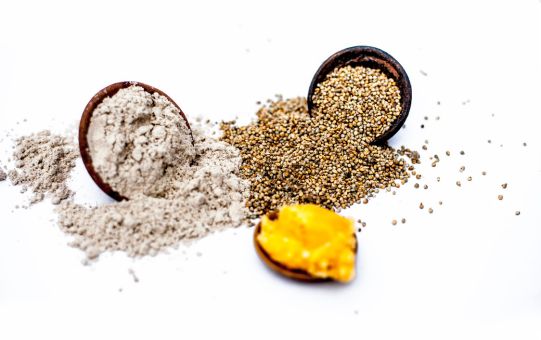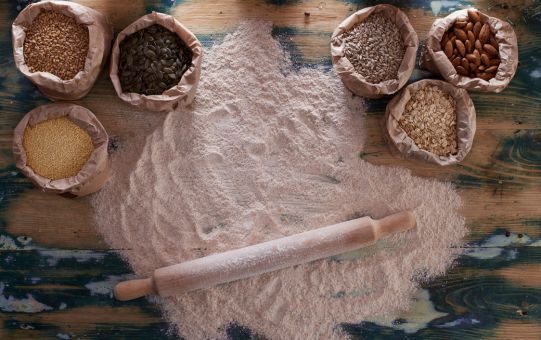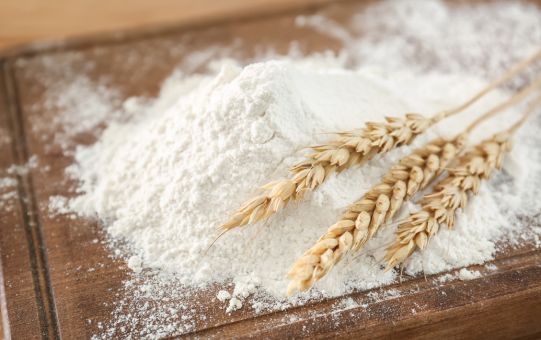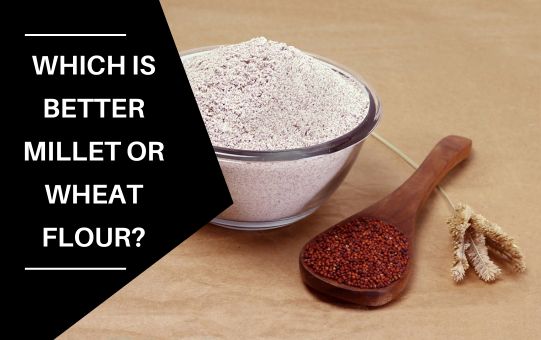Everyone is fond of eating millet and wheat, so let’s discover WHICH IS BETTER Millet or WHEAT FLOUR for your better health and dietary needs. also, explore the culinary application, benefits, and nutritional profile to make an informed choice.
Are you torn between the age-old debate of which is better millet vs wheat flour? Well, you’re not alone! The quest for healthier food options has led many individuals to explore alternative grains and flour. Millet and wheat flour are two popular choices, each with its unique set of benefits.
Here we will delve into the world of millet and wheat flour to help you determine which one suits your needs best. So, let’s roll up our sleeves and get ready to explore the culinary battleground of millet and wheat flour!
Contents
The Mighty Millet and the Wonderful Wheat Flour
Millet and wheat flour both hail from the grain family but have distinct characteristics that set them apart. Let’s take a closer look at each of them:
Millet: The Tiny Titan
Millet, often referred to as a “tiny titan,” is a group of small-seeded grasses that have been cultivated for thousands of years. Its small, round grains come in various colors, including white, yellow, and red. Millet is a staple food in many parts of the world, especially in Asia and Africa.
Wheat Flour: The Staff of Life
Wheat flour, on the other hand, is derived from the common wheat plant and is a fundamental component of many cuisines worldwide. It’s versatility and widespread availability have made it a staple in households for centuries.

The Nutritional Showdown: Millet vs. Wheat Flour
To determine which flour is better, we need to examine their nutritional profiles. Here’s a head-to-head comparison:
| Nutrient | Millet (100g) | Wheat Flour (100g) |
| Calories | 378 | 364 |
| Protein | 11g | 10.3g |
| Fat | 4g | 1.2g |
| Carbohydrates | 73g | 76g |
| Fiber | 8.5g | 3.4g |
| Calcium | 8mg | 28mg |
| Iron | 3.2mg | 1.5mg |
| Magnesium | 114mg | 25mg |
| Potassium | 195mg | 115mg |
| Vitamin E | 1.8mg | 0.1mg |
| Vitamin B6 | 0.3mg | 0.1mg |
While millet and whole wheat flour have similar calorie counts, there are notable differences in their nutrient profiles. Millet takes the lead in terms of protein, fiber, iron, and magnesium content.
On the other hand, wheat flour boasts higher levels of calcium and potassium. Now, let’s dig deeper into their respective benefits.
Read Also>>> What Are Differences In Millet Vs Rice Taste?
The Health Benefits Battle
Millet’s Marvelous Advantages
Millet is often celebrated for its impressive health benefits, making it a favorite among health-conscious individuals. Here’s a closer look at what millet brings to the table:
Rich in Nutrients:
Millet is packed with essential nutrients, including protein, dietary fiber, and B vitamins. These nutrients contribute to overall well-being and help maintain healthy body functions.
Gluten-Free:
For those with gluten sensitivities or celiac disease, millet is a fantastic alternative. It is naturally gluten-free, making it a safe option for individuals who need to avoid gluten in their diet.
Heart Health:
Millet contains a good amount of magnesium, which plays a vital role in promoting heart health. Magnesium helps regulate blood pressure and maintain a steady heartbeat.
Digestive Health:
The high fiber content in millet aids in digestion and helps prevent constipation. It adds bulk to the stool, promoting regular bowel movements and a healthy digestive system.
Antioxidant Properties:
Millet is rich in antioxidants that help fight off harmful free radicals in the body. These antioxidants protect cells from damage, reducing the risk of chronic diseases like cancer and heart disease.

Wheat Flour’s Wonderful Attributes
Wheat flour, too, has its fair share of health benefits that cannot be overlooked. Let’s uncover the advantages it brings to the table:
Abundance of Energy:
Wheat flour is a great source of carbohydrates, providing the body with the energy it needs to function optimally. It is an excellent choice for athletes or individuals with high energy requirements.
Bone Health:
Wheat flour is fortified with calcium, which is crucial for maintaining strong and healthy bones. Adequate calcium intake can help prevent conditions like osteoporosis.

B Vitamins:
Wheat flour contains a range of B vitamins, including thiamine, riboflavin, and niacin. These vitamins play a crucial role in converting food into energy, supporting brain function, and maintaining a healthy nervous system.
Iron Boost:
Wheat flour is fortified with iron, an essential mineral that helps transport oxygen throughout the body. Adequate iron intake is necessary to prevent iron deficiency anemia.
Read Also>>> Which One Is Best Quinoa Vs Millet For Weight Loss?
Which Is Better Millet or Wheat Flour?
Now that we’ve explored the nutritional profiles and health benefits of millet and wheat flour, the question remains: which one is better? The answer ultimately depends on your individual dietary needs, preferences, and health considerations.
Factors to Consider
To make an informed decision, here are some factors to consider:
Gluten Sensitivity:
If you have gluten sensitivities or celiac disease, millet is the clear winner as it is naturally gluten-free. Wheat flour, being a gluten-containing grain, should be avoided in such cases.
Nutritional Requirements:
If you’re looking to boost your protein and fiber intake, millet is the go-to choice. However, if you’re seeking calcium and potassium, wheat flour may be a better option.
Culinary Applications:
Both millet and wheat flour have versatile culinary applications. Millet can be used in porridges, salads, soups, and even as a rice substitute. Wheat flour, with its gluten content, is ideal for baking bread, cakes, and pastries.
Conclusion
In the battle between millet and wheat flour, there is no definitive winner. Both flours have their unique nutritional profiles, health benefits, and culinary applications. The choice between the two depends on your specific dietary needs, preferences, and health considerations.
If you have gluten sensitivities or celiac disease, millet flour is the obvious choice as it is naturally gluten-free. It also boasts higher levels of protein, fiber, iron, and magnesium. On the other hand, wheat flour is a good source of energy, calcium, and B vitamins.
Frequently Asked Questions (FAQs)
Can Millet And Wheat Flour Be Used Interchangeably?
While both flours have their unique properties, they can be used interchangeably in some recipes with minor adjustments. However, keep in mind that the texture and flavor may differ.
Are Millet And Wheat Flour Suitable For Weight Loss?
Both millet and wheat flour can be included in a balanced weight loss diet. However, portion control and overall calorie intake should be considered.
Is Millet More Expensive Than Wheat Flour?
The cost of millet and wheat flour may vary depending on factors such as geographical location and availability. Generally, millet may be slightly more expensive than wheat flour.
millet or wheat which is better for diabetes?
Millet is known for its low glycemic index, making it a favorable choice for individuals with diabetes. It causes a slower rise in blood sugar levels compared to wheat flour.
Can Millet And Wheat Flour Be Used In A Gluten-Free Diet?
Millet is naturally gluten-free and safe to consume for those following a gluten-free diet. However, wheat flour contains gluten and should be avoided in a gluten-free diet.
Which Flour Is More Readily Available?
Wheat flour is more widely available in grocery stores and supermarkets compared to millet flour, which may be found in specialty or health food stores.

